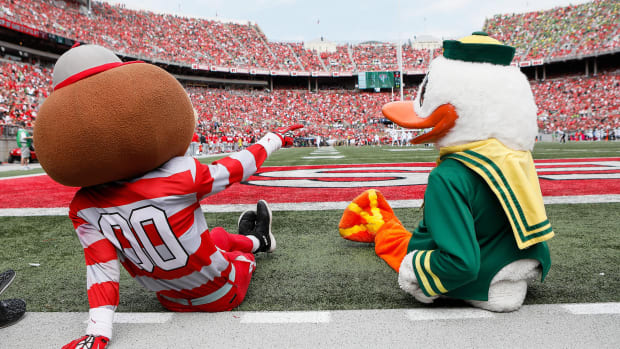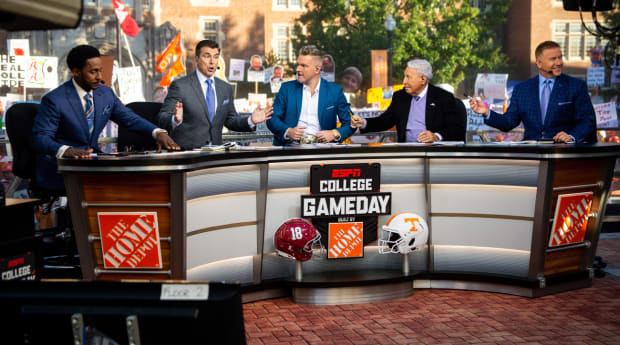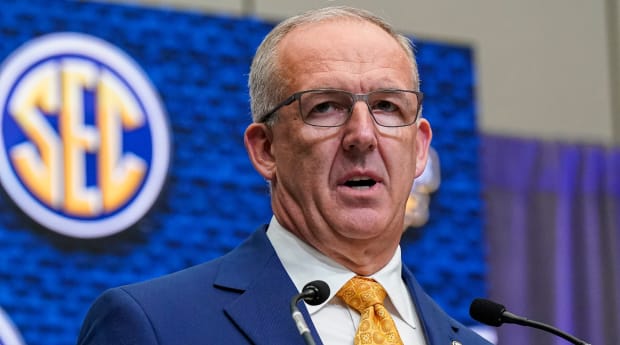“This was the story of Howard Beale, the first known instance of a man who was killed because he had lousy ratings.”
The final words of the 1976 Academy Award–winning movie Network can be applied to current events in college athletics. This is the story of the Pac-12, the first known instance of a conference that was killed because it had lousy ratings. (Or, at least, a lousy media deal.)
Network was an apocalyptic satire of the corrosive effects of the revenue-obsessed television industry. It rang a clear bell of unsettling truth that resonates prophetically today. The film’s climactic scene featured “Mad Prophet of the Airwaves” Beale being gunned down on live TV during the show he hosted.
TV came for the Pac-12 on Friday, firing the likely fatal shots at a league that has stood for 108 years in various iterations.
Lousy ratings. Lethal.

Adam Cairns/Columbus Dispatch/USA TODAY Network
This was a slow build to a sudden death. The conference put itself in the crosshairs with its disastrous Pac-12 Networks brainstorm of 2012, with then commissioner Larry Scott failing to secure broad distribution for the channel and dooming many of the league’s sporting events to relative obscurity. Current commissioner George Kliavkoff subsequently failed to land a lucrative media rights deal over the past year. Outflanked by competitors and lacking urgency, he wound up trying to sell a streaming-centric plan that was short on guaranteed money and long on doubt.
Thus on Friday, Oregon and Washington fled for the media riches of the Big Ten—even at a discount rate—following fellow Pac-12 evacuees USC and UCLA, who announced their 2024 departures last year. Colorado pulled the ripcord on the Pac-12 last week, landing in the Big 12. Arizona, Arizona State and Utah could all follow the Buffaloes to the Big 12 soon.
That’s a debilitating loss of the primary college TV draws in the Los Angeles, Portland, Seattle and Denver markets, with Phoenix and Salt Lake City perhaps up next. The “Conference of Champions”—home of more NCAA championships than any other league in history—has been all but eradicated. Fox and ESPN have carved up the landscape with little regard to how everything has fit together for decades.
It’s a sporting travesty, an unconscionable development that severely damages the cultural fabric of college sports. It destroys regional flavor, makes a mockery of geographic sense, rebukes the notion of academic importance, insults millions of fans and encourages wanton fiscal irresponsibility.
And nobody in charge cares. TV told the university presidents and athletic directors and conference commissioners to do it, so they did.

Brianna Paciorka/News Sentinel/USA Today Network
(Sources tell Sports Illustrated the Atlantic Coast Conference made a late attempt at delivering a life raft to the Pac-12, in the form of a potential scheduling arrangement or other partnership that could create additional revenue for both leagues. While not entirely selfless, the ACC was willing to do something other than backstab another conference fighting for survival. That qualifies as a Mother Teresa move in the current climate. That #Pac12AfterDark plot twist late Thursday helped breathe a little life into the league heading into a meeting Friday morning, but it was short-lived.)
While conference expansion and contraction are hardly new, this represents a new frontier in the crass realities of realignment. The Big East was raided earlier this century for several of its football members, but that was never the soul of that conference. The Big 12 was poached for Nebraska, Texas A&M, Missouri and Colorado (hello again), but the league didn’t exist until the mid-1990s and was a constant kettle of discontent thanks to the heavy hands of Texas. The Pac-12, which has sent teams to the Rose Bowl since its origin in ’02, represents one of the original pillars of college sports. And now we see how easily a pillar can be knocked down, if not anchored in a foundation of money.
Fans of many affected schools are, like Beale once bellowed, mad as hell. But there is no follow-up with the second half of Beale’s catchphrase. They’re going to keep taking it.
They always do. That’s the complication here. College football is run by heedless oligarchs who sold out to the networks, and the networks will stop at nothing in pursuit of more money and power. So the schools will keep exploiting the athletes and ruining rivalries and hurting their own win-loss records, all while assuring fans that increased revenue is worth rooting for and “student-athlete welfare” comes first.
And the public will buy it, or at least not push back to the point of rejecting the grift. Because we’ll never quit the sport. That’s been proven repeatedly.
We’ll keep watching. They’ll keep spending on coaching salaries, administrative bloat and ostentatious facilities, and buying their way out of irresponsible contracts. In need of budgetary restraint, the answer instead is to find more money to blow.
The clearest proof of how far astray we are from the college part of college sports is that Stanford and California are realignment spare parts. Stanford is the single-most academically prestigious institution still involved in FBS-level athletics. Cal is not far behind, tied with UCLA as the highest-ranked public schools that play big-time sports in the U.S. News & World Report’s national university rankings. Yet they could both be left without power-conference affiliations in the wake of this raid on the Pac-12.

Stan Szeto/USA TODAY Sports
Stanford has won the most national championships of any school in history (134). It has won the Learfield Cup for all-sports excellence 26 times out of the award’s 29-year history, including the 2022–23 academic year. It routinely produces Olympians and other future professional athletic stars. As in the academic realm, Cal is not far behind its Bay Area peer school in terms of all-sports excellence and heritage.
For those reasons, the university presidents in the Big Ten were interested in adding the Cardinal and the Golden Bears. But TV execs had other ideas, pointing to soft attendance and viewership numbers. Guess who won that taffy pull? Even in the Big Ten, which has a number of highly esteemed academic institutions, TV calls the shots. Thus Stanford (and maybe Cal) could be weighing going independent or even deemphasizing football.
Lousy ratings. Lethal.
For the four Pac-12 schools with enough gridiron clout to land in the Big Ten? Be careful what you cash checks for. A path to the 12-team College Football Playoff that debuts in 2024 would have been easier in the old league, without question. The travel and academic workload would have been more manageable. The in-state rivalries would have been intact. Conference titles would have been more attainable. A lot is being surrendered.
When November comes and the L.A. teams are playing under leaden skies in Piscataway, N.J., and State College, Penn., and West Lafayette, Ind., and Champaign, Ill., maybe they can light the sideline heaters with $100 bills from the league revenue deposits. With an 18-team league, the schedules will encroach even further into weeknights, with Thursday and Friday games likely unavoidable. When Oregon and Washington athletes wind up taking proctored midterms in a conference room at a hotel in College Park before a game against Maryland, be sure to thank the school presidents for those blessed educational opportunities.

Dale Zanine/USA TODAY Sports
If anything, the Big Ten’s breaking the 16-team conference ceiling could trigger further movement toward the long-prophesied consolidation of power into two or three megaconferences. The Big Ten and SEC can become the AFC and NFC, perhaps shedding ancient members and adding more lucrative new ones. It would be NFL Lite, with less talent, having sucked nearly all the charm out of the college game.
In Network, business tycoon Arthur Jensen launches a towering sermon to drill into TV show host Beale how the world really works: “There are no nations. There are no peoples. There are no Russians. There are no Arabs. There are no third worlds. There is no West. There is only one holistic system of systems, one vast and immane, interwoven, interacting, multivariate, multinational dominion of dollars. Petro-dollars, electro-dollars, multi-dollars, reichsmarks, rins, rubles, pounds and shekels.”
In college sports, there are no regions. There are no loyalties. And now there is no West, in terms of having its own home base and cultural center. There is only one holistic system of systems, and the system is driven by choices people make when they turn on the TV on Saturday afternoons.
Big ratings rule everything. Lousy ratings are lethal. Write it on the Pac-12’s tombstone.







